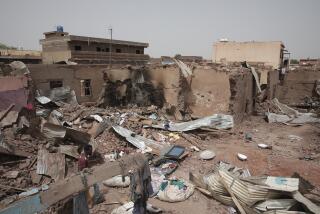Sudan--Africa’s Largest Nation Links Arab North, Black South
- Share via
THE COUNTRY
Background
Africa’s largest nation, Sudan covers 967,000 square miles, more than one-fourth the size of the United States. It borders on eight other countries and the Red Sea, giving it a strategic position in northeastern Africa. Stretching more than 1,200 miles from Egypt in the north to Kenya and Zaire at its southern borders, Sudan forms a transition between Arab and Muslim and largely desert northern Africa and forested, subtropical, black-inhabited central Africa. The Nile River and its tributaries provide irrigation for parts of eastern Sudan, and link Sudan to Ethiopia on the east and Egypt.
ECONOMY
Sudan, its economy mostly agricultural, is one of the world’s poorest countries. Cotton is a major cash crop, followed by gum arabic, of which Sudan produces most of the world’s supply. Sorghum, sesame seeds, peanuts, castor beans, wheat and sugar cane are also produced, and camels and sheep are raised for export. Oil has been discovered in the south, but regional opposition and a simmering rebellion have blocked its development. Drought has blighted Sudan and its neighbors since 1982, adding hundreds of thousands of refugees to an already strained economy.
POPULATION
The population, estimated at 22 million, reflects two distinct cultural traditions. About 70% are Arabic-speaking, mainly Muslim, living in the northern two-thirds of the country. In the south are blacks, some of them Christian, many following traditional animist beliefs.
HISTORY
Encompassing Nubia and the Cush kingdom in ancient times, what is now Sudan resisted incursions from Egypt, but increasingly was infiltrated by Islamic people from the north, and in 1821 was conquered and unified by Egypt. The southern blacks remained animist. The Egyptians made Khartoum their headquarters in the region, and developed Sudan’s trade in ivory and slaves. Opposition to Egyptian administration flared into revolt in 1881, and an Anglo-Egyptian force reconquered the region in 1896-1898. Sudan threafter was governed as an Anglo-Egyptian condominium, becoming self-governing in 1954 and fully independent on Jan. 1, 1956. Southerners fearful of northern Muslim domination began a revolt that was to last until 1972.
The continuing rebellion in the south complicated already severe problems for the new government and helped spark the 1969 coup that brought Col. Jaafar Numeiri to power. Numeiri established a leftist government, staved off successive coups, and presided over an agreement signed in 1972 in Addis Ababa, Ethiopia, to end the southern rebellion. The pact provided for an autonomous southern Sudan, and its terms were incorporated in the new Sudanese constitution of 1973. But southern disaffection continued to simmer over administrative and economic grievances, flaring up over oil and water development plans that southerners believed favored the north at their expense, and over Numeiri’s imposition in 1983 of Muslim law bringing floggings, amputations and other changes resented by the non-Muslim south.
FOREIGN RELATIONS
While formally nonaligned, Sudan has shifted its ties as circumstances changed. Relations with Ethiopia were warm before the 1974 coup that overthrew Emperor Haile Selassie and brought a Marxist regime to Addis Ababa; ties with Ethiopia recently have been strained. Sudan under Numeiri has had close ties with the United States, and a special relationship with neighoring Egypt. Sudan has been a bitter foe of Libya, which it has repeatedly accused of aiding the rebels in southern Sudan.
More to Read
Sign up for Essential California
The most important California stories and recommendations in your inbox every morning.
You may occasionally receive promotional content from the Los Angeles Times.













